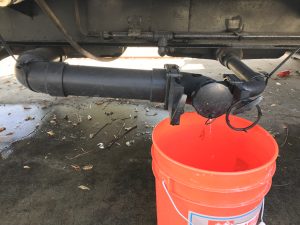As we break in all the systems, dormant bugs are bound to show themselves, as was the case with the gray water holding tank’s blade valve.
Most RVs have three holding tanks:
- Fresh water, which is water that comes out of the faucets when you turn them on (except when you’re hooked up to an external water supply, but that’s beside the point).
- Gray water, which is where the water that flows down your sink and shower drains ends up. This is generally dirty, but not raw sewage.
- Black water, aka sewage. Everything that goes down the toilet ends up in here. This is a toxic mess.

The black tank and valve (the pipe and handle on the left), and the gray tank and valve (right), joining into a single outlet (with a cap on). The wet ground is from washing the trailer, *not* gray water on the ground.
The black and gray tanks each have an outlet so you can empty them at a dumpstation, or right in your spot if they offer sewage hookup. How often you do this depends on how big your tanks are, among other things. The outlets for each tank have a “blade valve” which opens to let the stuff out of the tank and through a Y connector which joins both outlets into a single pipe which you connect to the outside world. By having two valves upstream of where the tanks are joined, you can keep them isolated from one another – you wouldn’t want the smell of sewage, or worse, coming up through the kitchen sink right?
After the first time I opened the gray water tank’s valve to empty it, it never quite closed up tight again – it was a little drippy. This is a bad sign that one of its seals isn’t watertight anymore, so I picked up a replacement valve – plus one for the black tank, just in case.
The Fix (and near disaster)
Being on the road and not having easy access to an RV repair yard, and since I was planning only on fixing the gray valve for now – being basically just dirty water – I decided to do the fix stealthily at our first stop, while Stephanie was napping with Wes. The change looked easy enough, involving these steps:
- Make sure the gray tank is empty – since we had hookups in the campground that part was easy.
- Remove four bolts.
- Remove the old valve and pull out the old seals.
- Install new seals.
- Put the new valve in – same brand and model, so everything should just line right up.
- Tighten down four bolts.
- Done!
Everything seemed easy enough, a 10 minute job under the best conditions, but the first challenge was that the bolts I was trying to remove were completely rotted – 75% rust, then just fell apart when I applied a wrench. I had to improvise to remove them, which meant taking a little longer than I hoped to take, making the illicit job more obvious to our neighbors should they look out their windows.
Once I finally got the bolts removed, I wiped things down, popped in the new seals, fit the valve in place, and started to tighten the bolts down.
About halfway through the process, though, I heard the water come on in the trailer – Stephanie woke up and was running the sink… oh fuck! That water was now about to come straight down into my lap if I didn’t get the valve bolts tightened, or if I hadn’t done something right – so instead of a controlled test, I got a live test of whether the new valve would hold. If it didn’t, we’d be dumping dirty (though again, not toxic) dishwater out under our trailer.
I wouldn’t be writing this if it had turned out badly – I’d probably still be dealing with the EPA or something – but it was a nice wakeup, and taught me a few new lessons:
- Turn off the water inlet when working on the gray tank, so even if someone turned on the faucet nothing would flow. Same for black tank.
- Tell everyone in the trailer what your plans are, even if you think they will sleep through the whole process.
An Aside about Valves
Valves are, in essence, logical devices, and the same logic that governs electronic circuitry also applies to water, air, and other types of valves. In fact, in many parts of the world, what we call “vacuum tubes” – an essential early computing technology – are called valves.
Many people have created computing devices – for fun, or even practical reasons – using complex arrangements of pipes carry water through valves.